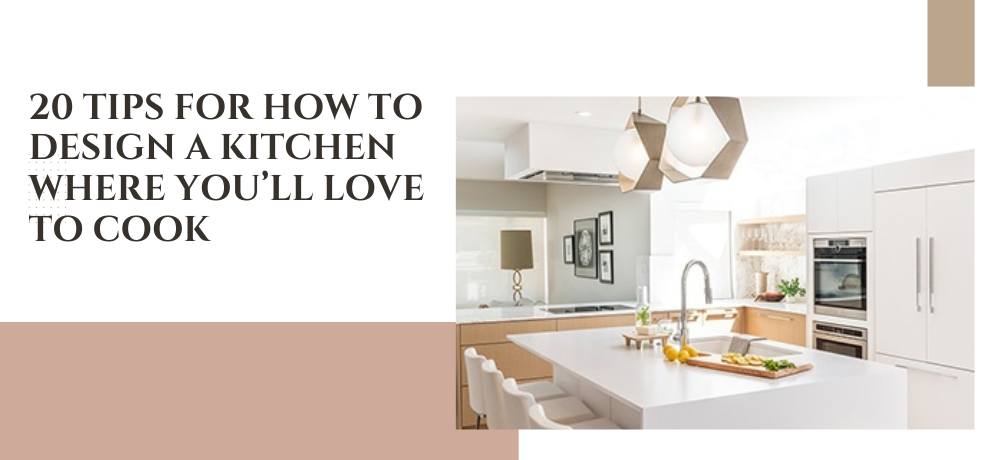20 Tips for How to Design a Kitchen Where You’ll Love to Cook

Your kitchen is more than just a place to prepare meals; it's the heart of your home, where memories are made and conversations flow. Whether you're renovating an existing kitchen or designing one for a new construction project, creating a space that reflects your style and meets your functional needs is essential. At Laura Grist Interior Design INC., we understand the importance of kitchen design in enhancing both the aesthetics and functionality of your home. Here are 20 expert tips to help you design a kitchen where you'll love to cook.
1. Assess Your Needs
Before diving into the design process, take the time to evaluate how you use your kitchen. Consider your cooking habits, storage requirements, and the number of people who will be using the space regularly.
2. Establish a Budget
Setting a budget early on will guide your design decisions and prevent overspending. Be sure to allocate funds for both aesthetic upgrades and functional essentials.
3. Prioritize Functionality
While aesthetics are important, functionality should be your top priority in kitchen design. Ensure that the layout promotes efficiency and allows for smooth workflow between the cooking, prepping, and cleaning zones.
4. Choose Quality Materials
Invest in durable materials that can withstand the rigors of daily use. Opt for high-quality countertops, cabinets, and flooring that not only look great but also stand the test of time.
5. Maximize Storage
Effective storage solutions are crucial for keeping your kitchen organized and clutter-free. Incorporate ample cabinets, drawers, and pantry space to accommodate all your cookware, utensils, and pantry staples.
6. Optimize Lighting
Good lighting is essential for both practical tasks and creating ambiance in the kitchen. Incorporate a mix of overhead, task, and accent lighting to ensure adequate illumination throughout the space.
7. Consider Ergonomics
Design your kitchen with ergonomics in mind to minimize strain and fatigue while cooking. Ensure that countertops are at a comfortable height, and appliances are easily accessible.
8. Personalize the Design
Infuse your personality into the design by incorporating elements that reflect your style and preferences. Whether it's a pop of color, unique hardware, or custom features, make the space uniquely yours.
9. Create a Focal Point
Designate a focal point in the kitchen to draw the eye and create visual interest. This could be a statement backsplash, a stylish island, or a standout appliance.
10. Balance Form and Function
Strive for a balance between aesthetics and functionality in your kitchen design. Focus on creating a space that not only looks beautiful but also supports your culinary endeavors.
11. Pay Attention to Traffic Flow
Consider the traffic flow in your kitchen and ensure that pathways are clear and unobstructed. This will improve safety and make the space more user-friendly, especially in busy households.
12. Incorporate Smart Storage Solutions
Make the most of every inch of space in your kitchen by incorporating smart storage solutions such as pull-out shelves, lazy Susans, and vertical dividers. These will help maximize storage capacity and keep items easily accessible.
13. Choose the Right Appliances
Select appliances that not only fit your cooking needs but also complement the overall design aesthetic. Opt for energy-efficient models that will help reduce utility costs in the long run.
14. Think Beyond the Kitchen
Consider how your kitchen interacts with adjacent spaces and design accordingly. Whether it's an open-concept layout or a closed-off kitchen, ensure a seamless transition between areas for a cohesive look.
15. Embrace Natural Elements
Incorporate natural elements such as wood, stone, and plants to add warmth and texture to your kitchen design. These elements can help create a welcoming atmosphere and connect the space to the outdoors.
16. Don't Overlook Ventilation
Proper ventilation is essential for maintaining good indoor air quality and preventing cooking odors and moisture buildup. Invest in a high-quality range hood or ventilation system to keep your kitchen fresh and comfortable.
17. Consider Sustainability
Choose eco-friendly materials and appliances to minimize your kitchen's environmental impact. Look for products with certifications, such as ENERGY STAR and FSC (Forest Stewardship Council), to ensure sustainability.
18. Plan for Maintenance
Factor in maintenance requirements when selecting materials and finishes for your kitchen. Choose low-maintenance options that are easy to clean and resistant to stains and wear.
19. Seek Professional Guidance
Consulting with a professional interior designer can help bring your vision to life and ensure a successful kitchen design project. An experienced designer can provide valuable insights, creative solutions, and expert guidance throughout the process.
20. Enjoy the Process
Above all, enjoy the process of designing your dream kitchen. It's an opportunity to express your creativity and create a space that truly reflects your lifestyle and personality.
Designing a kitchen where you'll love to cook is a rewarding endeavor that requires careful planning, attention to detail, and a dash of creativity. By following these expert tips and working with a trusted design partner like Laura Grist Interior Design INC., you can create a kitchen that not only looks stunning but also functions seamlessly for years to come.
To learn more about our services and how we can help you design the kitchen of your dreams, please click here. If you have any questions or would like to schedule a consultation, we'd love to hear from you. Please feel free to call us at (604) 724-2551 or email info@lauragrist.com for more information.
Transform your kitchen into the heart of your home with Laura Grist Interior Design INC.